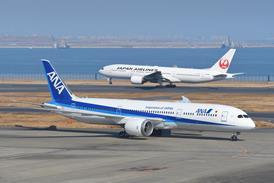US manufacturer's founder is in no hurry to develop larger machine as R22 and R44 pistons break sales records
Robinson Helicopter outdid itself, and the rest of the industry, last year by delivering a record 690 aircraft. That is as many piston singles as Cessna usually produces in a year, and is substantially ahead of the company's previous record - the 422 helicopters delivered in 2003. With more than 200 helicopters already on back order, the Torrance, California-based company is working to push its production rate up from 15 to 20 a week.
While the current sales success can be credited to the weak dollar, the two-seat R22 and four-seat R44 have long been bestsellers thanks to Robinson's reputation for conservative, cost-conscious engineering. It is a reputation that frustrates some in the industry who would like to see the company develop a new, larger helicopter, but founder, president and chief executive Frank Robinson is in no hurry.
"We're looking at a five-place helicopter, but it's all preliminary," says Robinson. "We've got a lot of difficulty coming up with an engine for it. We're looking at a [Rolls-Royce] Allison turbine, but they're so expensive, they use so much fuel and the maintenance is so high." Robinson outsells rival piston-powered helicopter manufacturers by a huge margin, but unlike Enstrom Helicopter or Schweizer Aircraft, does not have a light turbine single in its range.
The R22 Beta and larger R44 Raven are powered by Lycoming piston engines and have a reputation for low acquisition and ownership costs by helicopter standards. While a turbine is favoured for any five-seater, "we've also looked at various piston engines, including diesels, but we don't really have anything that we have decided on yet", says Robinson.
A dyed-in-the-wool engineer, Robinson worked on rotorcraft design at Cessna, McCulloch, Kaman, Bell and Hughes before founding his own company in 1973 with the vision of building a small, low-cost helicopter. The R22 was certificated in 1979 and became a bestseller. The R44 was certificated in 1992, and has overtaken the two-seater in popularity. To outsiders it seems only a matter of time before the company makes its next move up market.
"As far as going up line, we don't really have any plans on going anywhere beyond five passengers. We're not really crazy about a people carrier," says Robinson. "I don't really like the idea of producing something that seats eight or nine or whatever. I think that any bigger than a five-place is probably more likely to be a utility helicopter for cargo rather than for people. And we don't have any plans for that either."
Given its current sales success, Robinson is not under any internal financial pressure to launch another helicopter. The company added more than 200 employees last year to cope with demand for its existing R22 and R44, taking its workforce to around 1,100 people, and the factory was almost doubled in size with the addition of another 20,000m2 (215,000ft2).
Last year's record sales resulted from "the combination of several things that all came together at the same time", says Robinson. "The new Raven II model had the additional performance that customers really wanted, particularly in high-altitude areas such as South Africa," he says. "The new model stimulated a lot of sales and at the same time we had the weak US dollar rate. That dropped the price a lot - 27% for a helicopter overseas. That really stimulated our export market."
The 2004 delivery total was made up of 456 four-seat R44s and 234 two-seat R22s, compared with 294 and 128, respectively, a year earlier. R44 deliveries were split roughly three to one in favour of the Raven II, which offers 11% more take-off power than the Raven I. But while the weak US dollar clearly boosted deliveries - exports accounted for 65% of the total - the R22 and R44 have sold well since their introduction, with more than 4,500 produced.
"We have a good position marketwise," says Robinson. "In the good times people will buy our helicopter because they can afford it, and in bad times we get a lot of filter down from people who would buy a [Bell] JetRanger, or [Eurocopter] EC120, but cannot afford it." The simplicity and reliability of the Robinsons helps. "Our helicopters do have a good reputation, for the lack of maintenance required and for being good on reliability," says Robinson. "I would say probably the best feature is that they can use the helicopter for many days, or even weeks, and it does not require any maintenance until the 100 hour inspection."
Whatever eventual form any new Robinson helicopter takes, whenever it emerges, it is unlikely to diverge much from the philosophy embodied in the R22 and R44. "We're real happy with the two-bladed rotor for our market," says Robinson. "For our application, the simplicity of the two-bladed rotor head is a big advantage - just such simple things as the hangar space it's going to take up when you wheel it in." While the drawbacks of a two-blade rotor include more vibration at higher speeds, the R44 is no slouch. "In fact, it's faster than the JetRanger and pretty much in the same ballpark as the EC120," he says.
The low cost of the R22 and R44 belies the attention to detail in their design and manufacture. As a result, when it comes to a new helicopter, Robinson is taking it slowly and carefully - too cautiously, perhaps, for those anxious to see his company produce a new and larger helicopter, but he will not be rushed. "That is one of our hallmarks - engineering them to death," he says.
PETER GRAY / TORRANCE, CALIFORNIA
Source: Flight International























